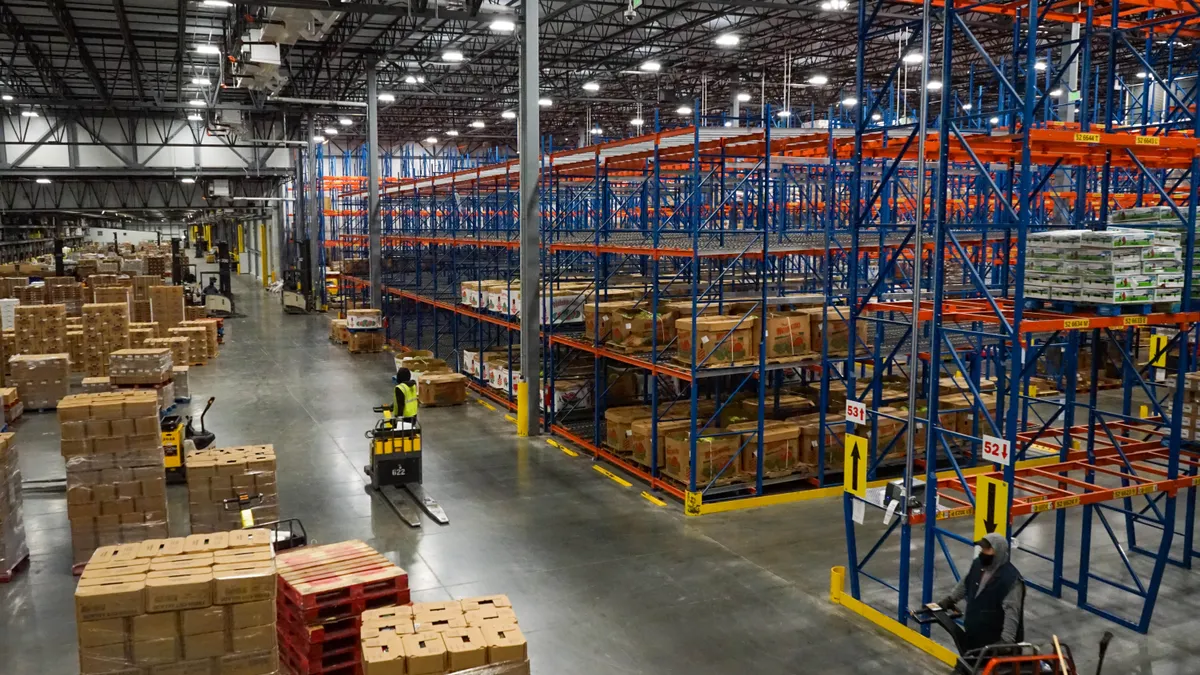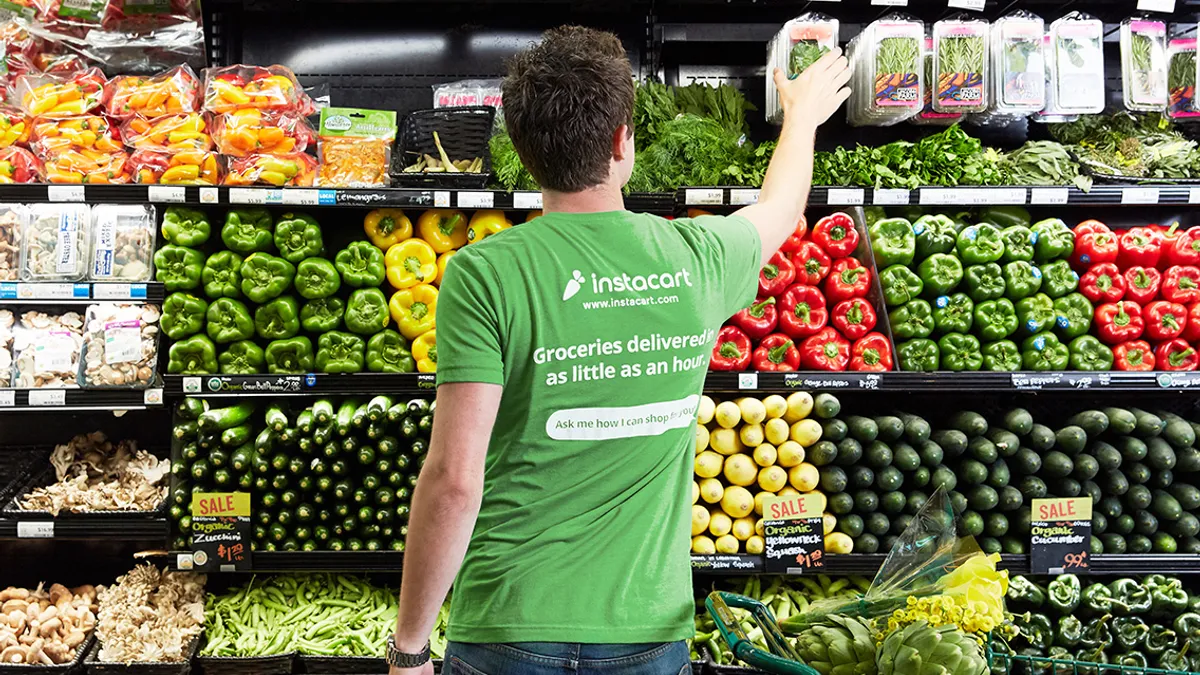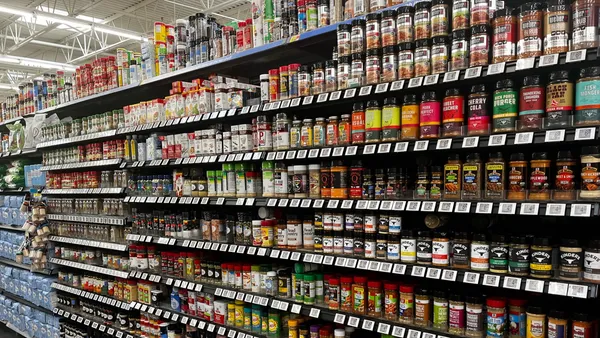Ahold Delhaize considered putting it all on hold.
"There were times when we talked and debated, you know, is it better to pause?" said Chris Lewis, executive vice president for supply chain at Retail Business Services, the subsidiary in charge of back-end innovation for the grocery group containing Giant Food Stores, Giant Food, Stop & Shop, Hannaford and Food Lion, along with Peapod e-commerce.
"But I'm glad we didn't," he said.
Lewis is overseeing the insourcing of distribution across Ahold Delhaize's banners — part of a $480 million supply chain transformation the company rolled out last year. The grocer is gradually distancing from distributor C&S Wholesale Grocers and implementing technological upgrades that will standardize how its banners operate.
The project won't wrap up until 2023, but the pieces are moving and so far it's on schedule — despite the pandemic hiccups.
More than a year ago, Ahold Delhaize hired a dedicated team to manage the transition to self-distribution. The grocery group's banners were still largely operated like separate entities, leaving the efficiencies of consolidating, promised when Ahold and Delhaize came together in 2016, on the table.
The company was in the midst of implementing new forecasting and replenishment technology when the pandemic brought with it a surge in demand.
"What we decided was, there was just more of an urgency to get those tools so that we can leverage them across the network," Lewis said. Staying on track added another layer of complexity to an already intense period in the company's history.
The dedicated team turned out to be essential to keeping the insourcing work on track when the pandemic elevated demand in March, Lewis said.
A warehouse worker drives a forklift through Ahold Delhaize's break-pack and frozen distribution center in Butner, North Carolina, which services the Food Lion brand.
"As we went through a lot of the [COVID-19] impacts, for the majority of the time, we left them alone on the transition. But I will say in March, in the beginning of April, it was 'all hands on deck' in the core supply chain," he said.
In between their system-wide work, RBS' distribution experts pitched in to find more third-party logistics partners and establish new cleaning protocols. They supported the IT team, which was swamped with keeping stores' systems running. Twice weekly meetings to check progress were instituted to keep communication going on the newly remote team.
"Every day was a different adventure at first," Lewis said. In late spring, when the banners got a handle on the demand, Lewis' team could return their focus to the transition, but times were still far from normal.
"We're going pretty fast in deploying the forecasting and replenishment tool, which I would have loved to have had back in March. So I think that will definitely be an advantage for us for the future. If anything, we accelerated the tools instead of delaying," Lewis said.
The Thanksgiving of it all
With a three-year horizon for the supply chain transformation, RBS and Ahold Delhaize knew there would be a few Thanksgivings during the transition. They did not know one of them would be during a pandemic.

Ahold Delhaize's answer to a unique and somewhat unpredictable Thanksgiving has been more inventory and more time.
"We had our top 300 items in the warehouse eight weeks earlier than we normally do," Lewis said. The company is ordering roughly 15% more of those top SKUs, too, to offer a cushion for outsized demand — when suppliers can meet it. Grocery suppliers have been cleaned out as they feel the sting of the bullwhip effect, but Lewis said in October there has been some improvement.
"We're seeing better fill rates today than we saw a month ago or two months ago. But it's historically low," Lewis said. These dynamics have led to some difficult conversations as suppliers face losing shelf space if they can't deliver.
To make up the deficits, the company used its internal sourcing resources. "We have a sourcing team, and we just cut them loose. And every day we would find items that vendors were telling us they couldn't get," he said. For paper products, the company found a vendor that normally serves colleges and with it, 500 trailers of toilet paper.
"We had our top 300 items in the warehouse eight weeks earlier than we normally do."

Chris Lewis
Executive Vice President of Supply Chain at RBS
Retailers of all stripes have been working to shift demand earlier on the calendar for the holiday season, to keep e-commerce operations moving smoothly and to help with supply management. Grocers could use the smoother volume, too, given already-stressed omnichannel and delivery operations. But that's a harder task for highly perishable products like turkeys and collard greens.
"What I'm trying to do is flatten the curve," Lewis said ironically. "I can ship and tell the stores, 'Don't even touch the product until four days before the holiday.'"
Anything that can be shipped ahead, given back-of-house space constraints, will be shipped earlier than usual.
By next Thanksgiving, roughly 65% of Ahold Delhaize's distribution network will have converted to self-distribution. Until then, the RBS team has the dual focus of keeping the transition on pace while also keeping stores full and safely operating. According to Lewis, the faster the company upgrades to new technology, the faster it will benefit.
A time for transformation
A key to making technological shifts in a moving supply chain is redundancy. Ahold Delhaize's banners ran new and old systems in tandem for four weeks before fully converting to new software.
"The one thing that we deliberately built into our timeline was appropriate time for both [the information technology team] to do their testing, but also the business to do user acceptance. And we probably added more to the timeline, just to make sure that we try to de-risk each of the programs," Lewis said.
"We're seeing the projects pick back up and continue to move down the path, because it's needed. It's not, 'I want to.' It's, 'I need to make sure I can survive, whatever comes next.'"

Brian Baker
Managing Director at Deloitte
At this point in the pandemic, planned supply chain investments are getting going again after an initial pause, said Brian Baker, managing director at Deloitte. Essential retailers need to up execution after months of elevated demand.
"We're seeing the projects pick back up and continue to move down the path, because it's needed. It's not, ‘I want to.' It's, ‘I need to make sure I can survive, whatever comes next,'" Baker said.
For a grocer like Ahold Delhaize, which built up its size through acquisitions, supply chain overhaul is somewhat expected but not necessarily in the grocer's grand style. Consolidation work often happens piecemeal over time.
"At the end of the day, if you have this scale, self-distributing is usually the way that most grocers want to go," Baker said.
The reason is efficiency in cost and effort. More closely coordinating procurement, movement of goods (Ahold Delhaize has one of the largest private fleets on the East Coast) and warehousing will give the company more control, allowing for better product availability and fresher product in stores, said Ahold Delhaize USA CEO Kevin Holt in announcing the initiative.
The incentives are clear for a company the size of Ahold Delhaize, said Baker, but the hold-up is often the initial investment.
"A grocery facility is probably going to need somewhere near a million square feet of refrigerated frozen, chilled and ambient [storage space]," said Baker. "That's a lot of capital to build from the ground up."
This rendering shows one of two automated frozen facilities Ahold Delhaize will build and bring online by 2023.
Ahold Delhaize's $480 million investment includes the acquisition of two warehouses from C&S along with new leased facilities to add seven warehouses to its existing network of 15 by 2023. Two of those will be automated frozen facilities in Connecticut and Pennsylvania.
So far this year, the company has completely insourced distribution for one category for one banner as an early test. It opened a meat plant in Rhode Island and began to upgrade forecasting and transportation software. All of the company's distribution centers were using common transportation management software as of October. The first warehouse to fully transition to direct purchasing and distribution will do so in February.
There are years of work still to come, but keeping the project on pace in a pandemic has offered Lewis's team a stress test for the ages.
"We didn't have any big blow-ups," Lewis said. "I should knock on wood."






















